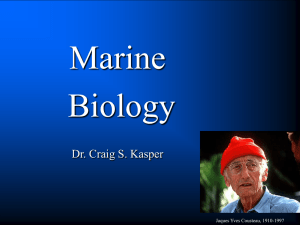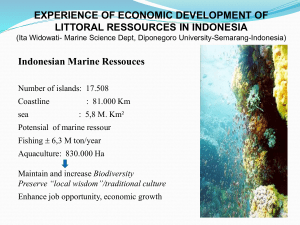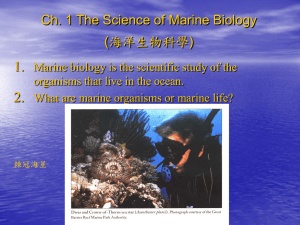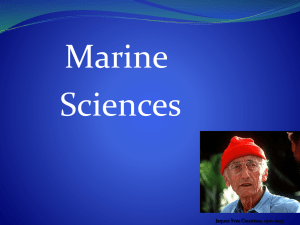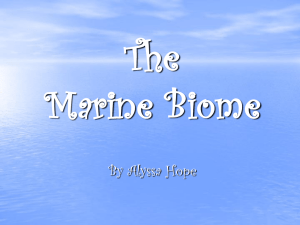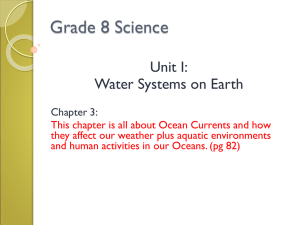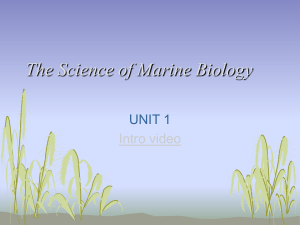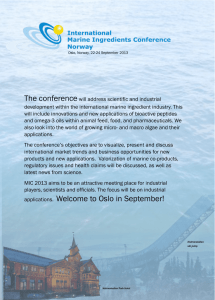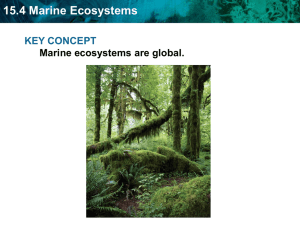Chap01 Science of Marine Bio
advertisement
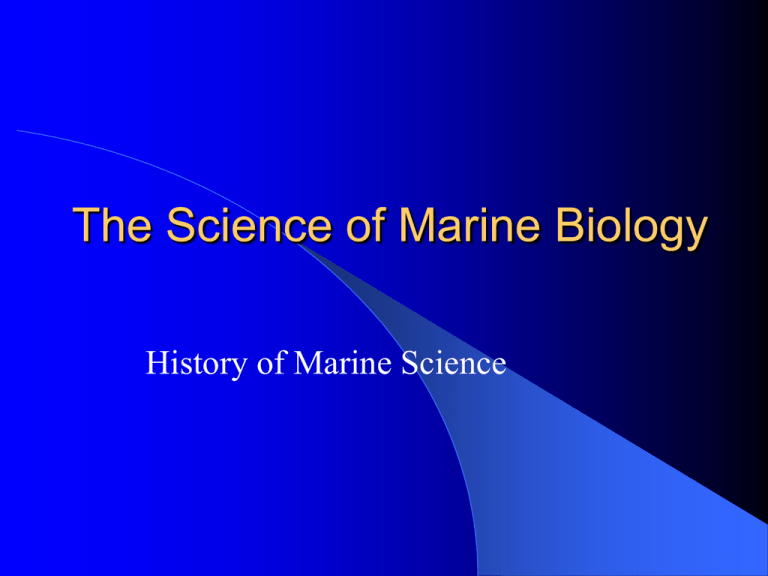
The Science of Marine Biology History of Marine Science Marine Biology- Defined The study of plants, animals, and other organisms in the ocean. To understand Marine Biology, you need to understand some marine chemistry, geology, social sciences, technology, seamanship, physics, and others Why study Marine Biology? Vast source of human wealth Food Medicine Raw materials Recreation Can be problematic also Invasive species destroy native species Diseases Erode piers, walls Foul ships, clog pipes Produce much of the oxygen we breathe Estimated that the ocean’s living systems are worth more than $20 trillion per year. World wide weather is a result of actions in and around the oceans. – El Nino – Hurricanes – Ever wonder why its cooler at the beach in the summer and doesn’t snow as much at the shore? History of Marine Biology People probably started learning about marine life the first time they saw the ocean Full of good things to eat Clam bakes as far back as the stone age Harpoons and fishhooks of bone and shell have been found Coastal people of every culture developed a practical knowledge of marine life Aristotle Aristotle (4th Century BC) is considered by many to be the first marine biologist Described many marine organisms Recognized that gills were the breathing apparatus of fish Vikings explored northern Atlantic – Leif Eriksson discovered North America Arab traders learned about wind and current patterns Pacific Islanders were consummate navigators James Cook James Cook – an English sea captain One of the first to make scientific observations Included a full-time naturalist in his crew 3 voyages that explored all the oceans First to make use of the chronometer Allowed him to determine his position Allowed him to make accurate charts Brought back specimens of plants and animals By 19th Century it was common to take a naturalist on board ships Charles Darwin Charles Darwin was such a naturalist Sailed on HMS Beagle – 5yrs Evolution through natural selection Proposed an explanation for formation of atolls Collected plankton and other specimens Middle 19th Century voyages specifically to study the oceans were made Edward Forbes Edward Forbes – 1840’s and 1850’s Studied the sea floor creatures Discovered that life at different depths is different Discovered previously unknown organisms Inspired interest in life on the sea floor Charles Thompson Charles Wyville Thompson – lead the HMS Challenger expedition 1872 was a light warship refitted to perform scientific observations on the sea floor Labs, quarters for scientific crew Fitted for dredging and water samples in deep water 3 ½ year voyage So much information was gathered, that after HMS Challenger returned, it took 19 years to publish the results – filled 50 volumes Measurements were made systematically, and meticulous records were kept Laid the foundation for modern marine science Many Marine biologists at this time did not get the chance to study living creatures. They got preserved specimens. Henri Edwards & Victor Andouin Henri Milne Edwards and Victor Andouin First to make regular visits to the shore to study life Soon labs were established that allowed marine biologists to keep organisms alive and work over longer periods Marine Biology Labs First was Stazione Zoologica – Naples Italy (1872) First American Marine Laboratory was Marine Bilogical Laboratory at Woods Hole, Massachusetts After these, others included o Hopkins Marine Station in Pacific Grove, CA oScripps Institution of Oceanography in La Jolla, CA o Friday Harbor Marine Laboratory in Friday Harbor, Washington World War II Sonar – sound navigation was developed Response to submarine warfare Ocean was found to be full of sound After WWII – Refinement of SCUBA Developed by Emile Gagnan and Jacques Cousteau Allowed marine biologists the opportunity to observe marine organisms in their natural habitat MARINE BIOLOGY TODAY Ships and shore based labs still very important Many universities operate their own research vessels (UCONN – RV UCONN) Project Oceanology – ENVIROLAB I, II, and III High tech submarines ROV’s - Remotely Operated Vehicles All 21 coastal states have marine labs Many Universities provide students the opportunity to study at graduate levels marine biology Computers can allow modern marine biologists to rapidly analyze lots of data Satellites – can capture pictures of broad views of the oceans Currents Phytoplankton Temperature Human impacts on the oceans
